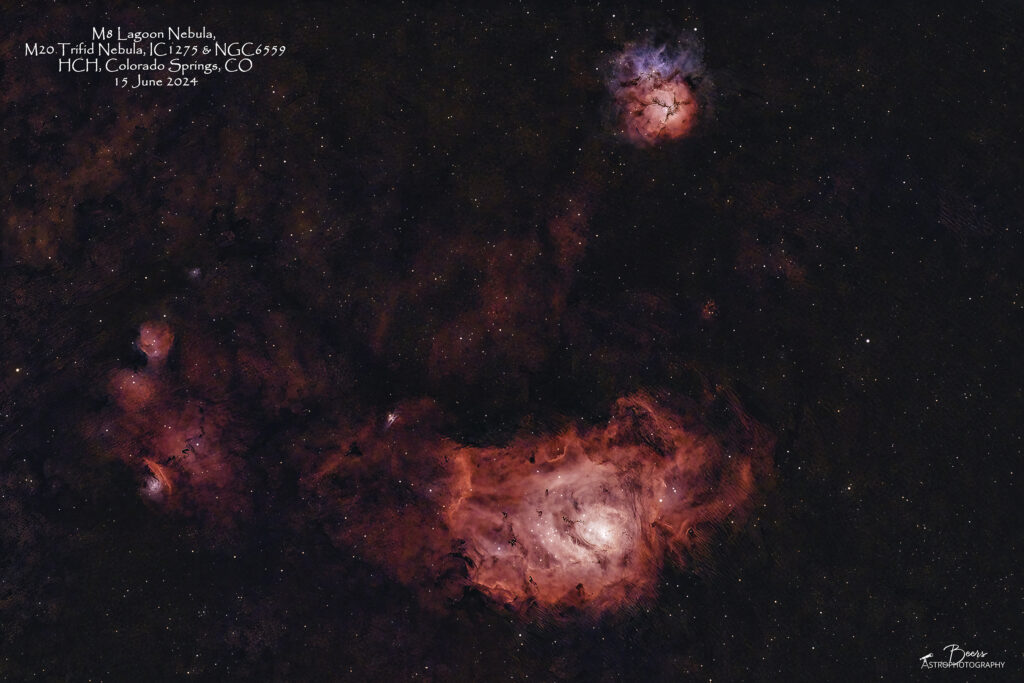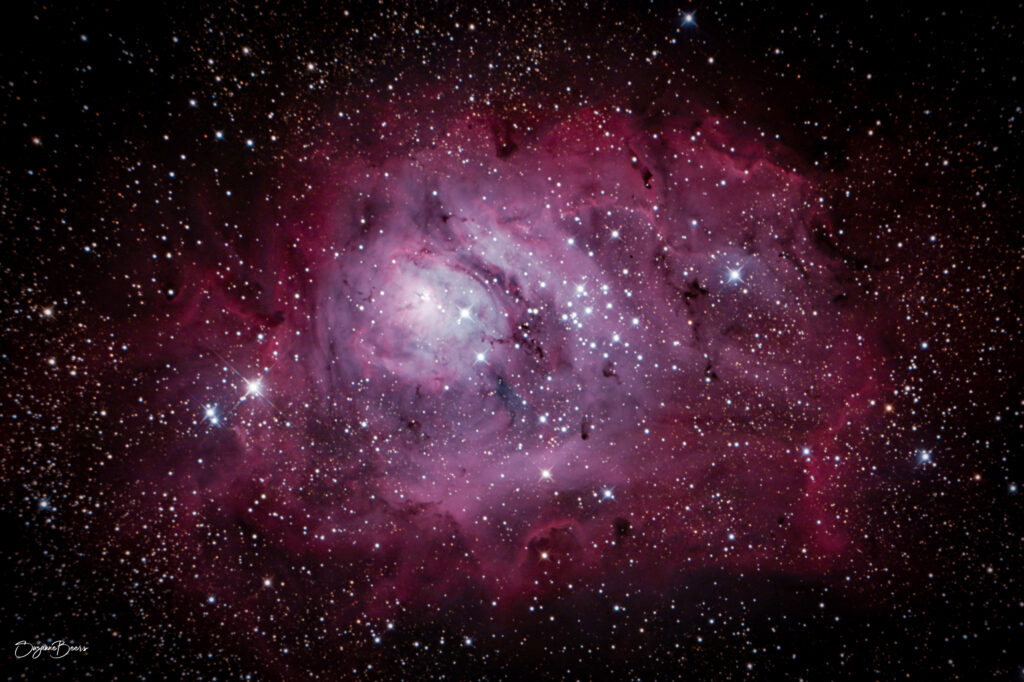
Target Fun Facts
M8 Lagoon Nebula: The Lagoon Nebula is a giant interstellar cloud in the constellation Sagittarius. It is classified as an emission nebula and as an H II region. M8 Lagoon Nebula was discovered by Giovanni Hodierna before 1654 and is one of only two star-forming nebulae faintly visible to the eye from mid-northern latitudes.
The Lagoon Nebula is estimated to be between 4,000–6,000 light-years away from the Earth. In the sky of Earth, it spans 90′ by 40′, which translates to an actual dimension of 110 by 50 light years. Like many nebulae, it appears pink in time-exposure color photos but is gray to the eye peering through binoculars or a telescope, human vision having poor color sensitivity at low light levels. The nebula contains a number of Bok globules (dark, collapsing clouds of protostellar material), the most prominent of which have been catalogued by E. E. Barnard as B88, B89 and B296. It also includes a funnel-like or tornado-like structure caused by a hot O-type star that emanates ultraviolet light, heating and ionizing gases on the surface of the nebula. The Lagoon Nebula also contains at its center a structure known as the Hourglass Nebula (so named by John Herschel), which should not be confused with the better known Engraved Hourglass Nebula in the constellation of Musca. In 2006, four Herbig–Haro objects were detected within the Hourglass, providing direct evidence of active star formation by accretion within it.
Other Catalog Designations: M8, NGC 6523, Sharpless 25, RCW 146, and Gum 72
Subtype: Emission Nebula
Distance from Earth: 4077 light years
Visual Magnitude: 6.0
Constellation: Sagittarius
{ From: https://en.wikipedia.org/wiki/Lagoon_Nebula and Stellarium }
M20 Trifid Nebula: The Trifid Nebula (catalogued as Messier 20 or M20 and as NGC 6514) is an H II region in the north-west of Sagittarius in a star-forming region in the Milky Way’s Scutum–Centaurus Arm. It was discovered by Charles Messier on June 5, 1764. Its name means ‘three-lobe’. The object is an unusual combination of an open cluster of stars, an emission nebula (the relatively dense, reddish-pink portion), a reflection nebula (the mainly NNE blue portion), and a dark nebula (the apparent ‘gaps’ in the former that cause the trifurcated appearance, also designated Barnard 85). The cover of the King Crimson album “Islands” depicts an image of the Trifid Nebula.
The Hubble Telescope close-up images show a dense cloud of dust and gas, which is a stellar nursery full of embryonic stars. This cloud is about 8 light years away from the nebula’s central star. A stellar jet protrudes from the head of the cloud and is about 0.75 light years long. The jet’s source is a young stellar object deep within the cloud. Jets are the exhaust gasses of star formation and radiation from the nebula’s central star makes the jet glow. The images also showed a finger-like stalk to the right of the jet. It points from the head of the dense cloud directly toward the star that powers the Trifid nebula. This stalk is a prominent example of evaporating gaseous globules, or ‘EGGs’. The stalk has survived because its tip is a knot of gas that is dense enough to resist being eaten away by the powerful radiation from the star. In January 2005, NASA’s Spitzer Space Telescope discovered 30 embryonic stars and 120 newborn stars not seen in visible light images.
Other Catalog Designations: M20, NGC 6514,[1] Sharpless 30, RCW 147, Gum 76
Subtype: Combination of an open cluster of stars, an emission nebula, a reflection nebula, and a dark nebula
Distance from Earth: 4,100 light years
Size: 21 light years
Apparent Size: 28’
Magnitude: 6.3
Constellation: Sagittarius
{Target information derived from: https://en.wikipedia.org/wiki/Trifid_Nebula and Stellarium }
Equipment: All equipment controlled by HP Probook running Sequence Generator Pro v4.4.0.1339
- Imaging (ASI2400-SC-LPro): ZWO ASI2400MC imaging camera with Optolong L-Pro LP filter on (Southern Cross) Askar FRA600 108mm f/5.6 Quintuplet Petzval Flat-Field Astrograph.
- Autofocuser: ZWO EAF Electronic Automatic Focuser – Standard (New 5V Version) (EAF-5V-STD)
- Mount: Rainbow Astro RST-135E (controlled by iHubo ASCOM driver)
- Polar alignment: QHYCCD camera (controlled by Polemaster for polar alignment)
- Autoguiding: Orion 60mm Multi-Use Guide Scope with Orion StarShoot AutoGuider Pro Mono Astrophotography Camera (controlled by PHD2)
Capture & processing notes: I’d received the RST-135E’s hand controller back from Tolga in early June, after he changed out its GPS card – the last errant (hopefully) piece of equipment to be brought back into working condition after the Chile trip. When it arrived, I took the telescope out onto the patio and tvalidated that everything was working correctly, but this was the first clear night to image with all the “fixed” equipment. Although there were several warnings from SGPro throughout the imaging session that the autoguider was struggling and recovery mode was invoked several times (I need to remember to focus the autoguider camera before the next imaging session), things went well – including the meridian flip that executed on its own at some point before the point when the mount was 20 minutes past the median point. I set an alarm and went out to do the meridian flip – SGP said it was about 1:40 minutes before the flip and there was about 45 seconds left in the exposure. So I selected “pause sequence” but forgot to check “run end of sequence actions.” When the sequence paused, I looked up at the mount and realized that it was already on the east side of the pier (i.e., it had already executed the meridian flip). Even though it was quarter moon, the LPro filter produced a good result – albeit not as good as the one below, imaged from the dark skies of Rocky Reservoir in July 2021. This is definitely on my imaging list for dark skies!
Processing: Captured in SGP, stacked in APP (Adaptive Airy), star removal with Starnet++, processing with LR/PS
Other images of this object

Capture Notes
This image was taken during my first fully successful night of imaging after struggling with the Canon EOS Ra consistently connecting to my laptop and AP control software for almost six months. During that trip to Rocky Reservoir in the far northwest corner of Colorado, I had two nights (9-10 July 2021) of gloriously clear and dark skies and fully successful imaging. I imaged M8 Lagoon Nebula, M16 Eagle Nebula, and NGC6960 Witch’s Broom from the Veil Nebula. I was still imaging with ISO800 at that point, afraid of the noise that might be induced with higher exposures – but this target was bright enough to shine through that rookie’s judgment call.
Equipment
Polar alignment: QHYCCD camera (controlled by Polemaster)
Imaging stream: Orion 8″ f/8 Ritchey-Chretien Astrograph Telescope, Canon EOS Ra
Mount: Sky-Watcher EQ6-R Pro Equatorial Mount (controlled by EQMOD)
Autoguider: Orion 60mm Multi-Use Guide Scope, Orion StarShoot AutoGuider Pro Mono Astrophotography Camera (controlled by PHD2)
All equipment controlled by HP Probook running Sequence Generator Pro v3.2.0.660.
Capture & Processing Notes:
Sequence Plan: ISO800; 50x180sec. Total exposure time: 2:30hrs. Captured 10Jul2021, 0136 – 0414MDT.
Captured: 10 July 2021
Shooting Location: Rocky Reservoir, Colorado
